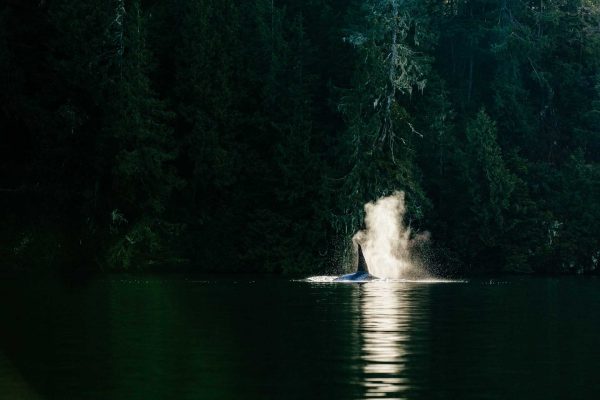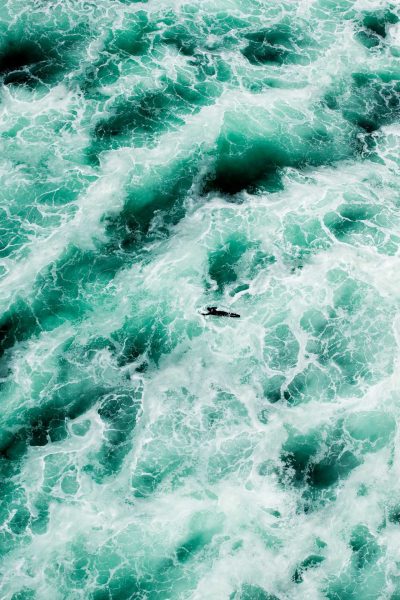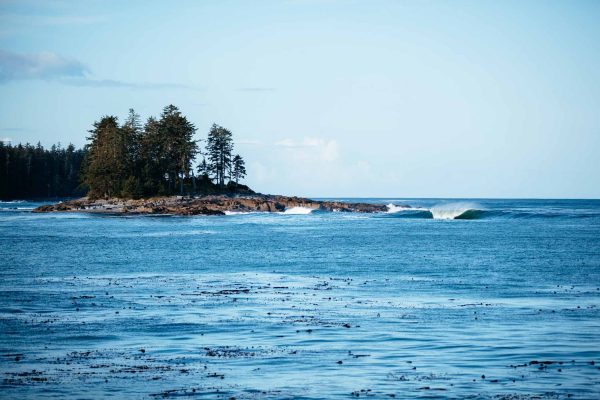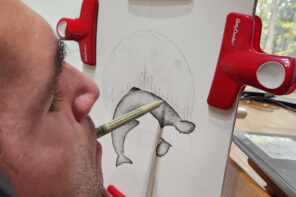As two photographers from two different countries, two different coasts and with a whole lot of water-housing between them, New York’s Ryan Struck met Vancouver Island’s Jeremy Koreski on a recent trip to Tofino, British Columbia hosted by AllSwell Creative, Tiny Atlas Quarterly and Earth Mission. We asked the two to have a chat for Whalebone.
While Koreski was splitting wood and building a fire, they talked about the dicey prospect of keeping lesser known surf spots secret, the paradox of environmental tourism and the coldest water the Canadian has ever paddled into.
Ryan: I want to talk about your work, the region of Tofino and photography in general. I found that photography can quite literally be a passport to anywhere in the world. I’ve used my own camera as a catalyst to go places, and found that most people are willing to bring you along solely because you have a camera and you can document [the trip]. So you wind up using your camera, which you love, and getting to see new places.
Jeremy: I one hundred percent agree. I just got back from Oklahoma and I felt like I had a passport into these people’s lives. One of the guys, Edwin Evers, is a famous fisherman in the area, and I feel like if I was just a fishing guy, I would never be able to be invited into his home and meet his family. But because we’re documenting him, my camera gave me a passport into his life. We got to hang out with him and his family, which was a really cool experience.

Jeremy. Photo: Ryan Struck
Jeremy: [Loud noises in the background] Sorry, I’m going to be making a fire here soon.
Ryan: I think your work is synonymous with where you live. So it’s so much easier to be inspired when you leave. What is it about being home in Tofino or on Vancouver Island that keeps you shooting? What keeps you so interested there?
Jeremy: [More loud chopping noises.] Okay, hang on a sec. I’m just splitting some wood. [More noise.] What keeps this part of the world fresh is showing people like you around, getting to experience it through new eyes. It was cool to see an out-of-towner’s perspective of where I grew up. I trip out sometimes like, “Wow, I never noticed that building” when someone photographs it—like a building I walked by my whole life and then you see a photo and you’re like, “I never thought of taking a photograph, that’s really cool.”
I think that’s how British Columbia stays fresh to me, but also the importance of putting more emphasis on conservation of the area. That’s what’s been driving my work lately. I love to travel, too. That Oklahoma job was very random but very cool. This guy Edwin Evers said that his dream since he was a kid was to travel to British Columbia and fish for steelhead. So, British Columbia is a pretty special place and the more I travel, the more I realize that I live in one of the most beautiful places in the world.

Schooner sunset. Photo: Jeremy Koreski
Ryan: Photography is an interesting pursuit in that you have to choose when to record the moment but in doing that you may be missing the experience for yourself. For example, let’s say a magazine sends you on a rafting excursion. As a photographer the best-case scenario is that everyone forgets you’re there and you make beautiful images documenting the trip. In contrast however, one might argue that you aren’t actually experiencing the trip itself. How do you make this distinction between shooting and enjoying the moment?
Jeremy: Well, I don’t shoot all the time, I guess that’s part of it. Like on the AllSwell x Tiny Atlas x Earth Missions trip. I had my camera but I was more-so just experiencing the trip. I was watching you guys a lot just seeing how are you were taking everything in. It’s cool to sit back and do that sometimes but like you said, when I’m on a trip and in it, the goal is the image.
I’ve noticed it a couple times before… when I’m so in it I forget where I am. There was this one time when I actually realized it and it kind of freaked me out. I was swimming around a sea lion rookery and I got into a group of about 200 females around me, and they’re pretty big—at least as big as me—and 200-300 lbs. I remember looking through my camera and I’m shooting away, shooting away. I got lost shooting and I was so in it having fun and I pulled my camera housing down from my eye, it was almost like a shock, “Holy shit I’m in the middle of 200 animals that could essentially tear me apart.” That kind of freaked me out.
I put my camera back up and just kept shooting and tried not to think about it. That was one of the times where if I didn’t have my camera with me I would have thought, “This is intense.” And I’ve noticed that with shooting wildlife more and more now; when you have the camera up, it’s almost like this shield around you.

Photo: Jeremy Koreski
Ryan: Some people go to Tofino on Vancouver Island to see and photograph certain things like crossing items off a checklist. What are some of the less expected places that you’d recommend somebody see or do.
Jeremy: If you’re here in the fall I would recommend you go swimming with the salmon. There are few places on the island but it hasn’t really caught on in Tofino because it’s still pretty new. That is one of the coolest things I’ve done, being surrounded by that many fish. They’re just so beautiful. So that would be one of the things I would recommend. It’s cool now while the masses aren’t doing it, right?
Going back to your earlier question about keeping photography fresh, there was a really good day at this wave and there was a guy from out of town who brought a crew up and then there was I think 4 or 5 other local guys. So when I showed up I was like, “Fuck, every angle is already being shot, why am I here?” So I swam, I went out with the fisheye and got deep. The waves are pumping so I stayed all day and climbed this tree like 60 feet up. The wind is howling, I’m getting bounced around, and I ended up getting a really cool shot that ran in SURFER [Magazine].
You just calculate things different and look at the scene. “What do I have to do that all these other guys aren’t doing?” I’m always moving and I’m always trying something different. I always want my work to be changing and I’m always looking for new angles and ways to shoot something that I’ve shot a hundred times before.

Marbled. Photo: Jeremy Koreski
Ryan: Damn dude, that’s a really positive way of looking at it! [laughs]
Jeremy: [laughs] That’s how I try to, anyway. And so that has kind of driven me to use more film. [Bella, Jeremy’s daughter, is heard in the background. Jeremy addresses her, speaking of his wife’s whereabouts.] Bella, she just went to the horses, she’ll be back in a sec.
Ryan: Do you explore much?
Jeremy: Oh yeah. Shit, I can name probably 10 spots that I know are going to be the most epic waves ever on the right day. Some of them I’ve been to and some of them I haven’t, but there’s a wave that’s close to Tofino that is going to blow people’s minds. So for me and surf photography, it’s still a pretty exciting time where I’m from because there are just so many [exciting] waves and the hardest thing is accessing them when they’re good.

Dark days. Photo: Jeremy Koreski
Ryan: So when you going to blow that spot up?
Jeremy: Yeah! [laughs] We’ll see, we’ll see. A friend found it. He’s actually one of the hardest-charging, exploring guys there is on the coast right now. He’s just driven to find these places and also document it, but in the right way. I am exploiting places whenever I take a photo because even if I don’t say where that place is, eventually when someone asks 100 times, someone’s going to give up some information. Eventually someone’s going to figure it out.
That kind of comes back to Tofino, too—just as far as tourism in general has gone up, however many thousands of percent, since I was a kid. A lot of people are going to Tofino to go to the hot springs or to go whale-watching. I feel like the more people that go outside and experience those things, the better chance our planet has of surviving. Because if people aren’t going to experience it in real life, just on TVs and shit, than we’re doomed.
Ryan: One thing that I thought was awesome in your book, This Is Nowhere, is the quote you open with that says, “Places do not belong to people, people belong to places.”
Jeremy: The ownership of land or water is so weird to me. “You can’t take photos here because we don’t want other people coming here.” Well, who’s to say that you have the right to say that, you know? You don’t. When you talk to non-surfers and you try to explain localism they just shake their head.

Zest. Photo: Jeremy Koreski
Ryan: I could use your argument for every jackass that’s out there blowing up secret spots. I think you should be able to take a picture wherever you want but some people are just irresponsible.
Jeremy: And that’s something I’ve taken into my consideration my whole career. I’ve never once named a spot. Ever.
Ryan: Never?
Jeremy: No. [Pause.] Unless it’s a fake name.
Ryan: [Laughter.] Nice, you just slipped up a little bit there, Jer!
Jeremy: When the magazine is running the shot, it’s [identified as] Canada. They don’t need to know more than that.

This is nowhere. Photo: Jeremy Koreski
Ryan: Have you been to the East Coast?
Jeremy: I haven’t been down to where you are [in New York], but I love the east coast of Canada that I’ve seen. It’s totally different than the West Coast. It’s the coldest place I’ve been in the water: 32.2 degrees and the air was -5 degrees or something nuts. We had driven from Nova Scotia four or five hours and the waves were pumping.
The parking lot was ice, we suited up and could see the waves in the distance. We ran down there and I just remember, not so much the cold, but when I first paddled out, the pressure around my ankles and wrists where the cold was getting in. All you guys are crazy, but that was some of the coldest water you can surf anywhere. What’s messed up is that when I went under a wave and came up the water felt warmer than the air and it was. When the water is almost freezing and it still feels warm [in comparison to the air], that’s pretty surreal.
Ryan: Are all Canadians stoked on planet Earth?
Jeremy: No. I’m sure you’ve heard of the Tar Sands?
Ryan: Yeah, in Banif?
Jeremy: It’s in Alberta, it’s one of the most polluting industries on our planet. It’s fucking our planet. There was a really good article by Outside Magazine on the Tar Sands and Aaron Huey did the photography. He really hit it on the head with his images. One that sticks out is this boy playing at a rest stop with all the smokestacks and fires burning and smoke… it looks like he’s in hell but it’s some kid playing with a soccer ball at a rest stop.
So many people are employed on the Tar Sands. I feel fortunate that I found something I love to do and can provide for my family and it’s not having a negative effect on our environment—other than driving around burning fuel in a car or boat or plane or helicopter. My whole take on that thing [fossil fuels] is, “Let’s bring on the alternative energy sources. Let’s figure out how to power that helicopter with something that’s not fucking us over.”

All eyes on me. Photo: Jeremy Koreski
There’s a huge portion of the country that believes very differently than I do. That’s the thing about getting more and more people outside, if we connect with those people. This came up on a trip we did trying to bring awareness to a pipeline. Someone said, “We need to get the people making those decisions in this experience, in this river, face-to-face with a grizzly bear, in a river filled with salmon.” That’s how those changes are going to be made eventually.
Ryan: Wow, what an incredible way to show someone how their decisions impact the planet. Maybe the beauty of Tofino, Vancouver Island and British Columbia fosters an appreciation for the Earth.
Jeremy: There are a couple organizations I’ve been working with, one is Raincoast and another is the Central West Coast Forest Society that’s based in Ucluelet. They’re going into rivers and salmon habitats destroyed by logging, and they start cutting things away. They see results immediately. A year after they’ve cleaned up a river, they’ll count salmon in it. I’m a 1% For The Planet member and that’s where my money’s been going.
Keep up with Jeremy and Ryan + their individual journeys around planet Earth, via Instagram, @jeremykoreski and @ryanstruck. Thank you both.










